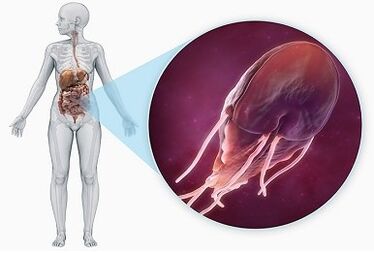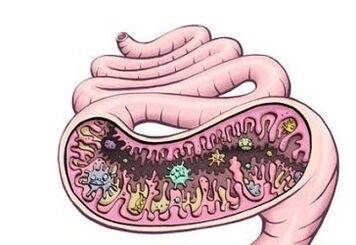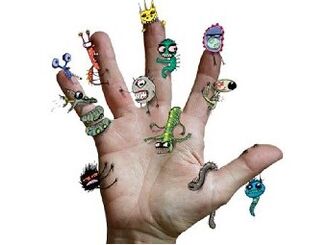Parasitism is such a form of inter -specific interaction, in which the representative of one type (parasite) in part or completely exists at the expense of a representative of another type (owner). The taxonomic list of parasitic forms affecting a person is extremely wide

Parasites are found among arthropods, molluscs, worms, fungi, simple organisms and this is not the whole list. Pathrot bacteria and viruses, from a medical point of view, are also parasites.
In this article we will talk about the parasitic forms of representatives of the kingdom of property (protozoa). Parasites are always an unpleasant and undesirable phenomenon, so to fight them effectively, you need to know as much as possible for them.
Kingdom representatives are often called single -celled organisms. These are creatures that consist of only one cell, which has constant shape, such as ciliates, or capable of cytoplasmic movement, such as Amoeba.
Many protozoa are equipped with movement organs, represented in the form of flagella, cilia or pseudopods. Their dimensions fluctuate from microscopic to several millimeters. The organism cage contains a group of organelles that perform functions similar to the organs of more complex organisms.
The kingdom is represented by almost 15, 000 species, most of which live in the aquatic and land environment.
However, there is a part of the single -celled organisms that prefer a parasitic lifestyle. The simplest parasites of a person can cause a disease such as protozoans - sometimes taking severe forms to death. Sometimes it is very difficult to get rid of parasites in the body.
Protozoa has a protective mechanism - transferring unfavorable environmental conditions to an inactive state. The cell is covered with a dense, impenetrable shell, transformed into cysta, and in such an unacceptable form it can be for a very long time. Incest is also used by the simplest to distribute them.

Change in species
The simplest persons of a person vary in the structure, the method of their introduction into the body and caused the disease. For better structuring of information, the main material related to unicellular organisms is briefly shown on the board.
Some representatives of the parasitizing protozoa in the human body, their short description:
| Type, caused diseases and organ systems, undergoing damage |
Symptoms |
Ways of infection, carriers |
The infectious phase of the parasite life cycle |
|---|
| The class is flareded |
obsession
Leishmaniosis of the skin or ulcer of pendinskaya, visceral leishmaniosis or azar castle
Skin, mucosa, blood, heart, adrenal glands, kidneys, bone marrow
|
Skin leishmaniosis is characterized by the formation of necrotic ulcers in the affected areas of the skin. Visceral leishmaniosis causes acute inflammatory reactions from the affected organs, with ulcers and hemorrhage. |
They fall into the bloodstream with a bite of a mosquito, with its saliva. Carriers - animals with warm blood, including humans; The carrier is a mosquito. |
Promastigote (Flagellates body shape). |
Lamp
Lambliosis
The mucous membrane of the small intestine, gall bladder.
|
Environment, allergies, asthma, depression, nerve disorders, cracks, dry skin, cholecystitis, etc. |
The fecal-oral route of infection through food and water. Carriers - animals with warm blood, including humans; Carriers - synthropic insects (flies, cockroaches). |
Cyst phase. |
Trichomonas (intestine, genitourinary, mouth)
Tricomoniasis
Great intestine, genitourinary system, oral cavity.
|
Itching, burning in the genital area, discomfort during urination, abundant unhealthy discharge from the genitals. Complications with the development of infertility are possible. |
The sexual path of infection; through the mouth; through the rectum; When the inhaled air; It is possible to transmit parasites at birth from mother to child. A carrier and carrier is a person. |
Anydo phase of the life cycle: Flagellates (adults), amoeboid (intermediate, most invasive), cyst. |
trypanosomes
African tripanosomosis or sleepy disease; American Tripanosomosis or Chagas Disease
Blood, lymph nodes, spleen, spinal fluid.
|
An increase in lymph nodes, pathological processes in the spleen liver, nervous system damage is characterized by excessive drowsiness, and often a fatal result occurs. The disease develops up to two years. |
Enters the bloodstream during the insect bite with its saliva; When you shed blood. The carrier is a warm -blooded animal, including humans, a carrier - a fly of Tseche (African Tripanosomosis), a tritomic bug (American tripanosomosis). |
Tripomastigote phase (characteristic of membrane oscillation and ability to move). |
| Spore |
Toxoplasm
Toxoplasmosis
Nervous system, eyes, muscles, digestive organs.
|
The latent and chronic form continues asymptomatic; Symptoms of an acute form are manifested by the affected organs. Most dangerous for pregnant women and newborn children leads to serious disorders and congenital pathology, until fetal death. |
Fecal-oral pathway of infection through raw milk, meat; with insect bites; During pregnancy from mother to child. Harshes and carriers are warm -blooded animals, including humans. |
Cyst phase. |
Plasmodium
malaria
Liver, red blood cells.
|
An increase in body temperature, chills, fever, can lead to serious kidney lesions, nervous system, a fatal result is possible. |
Enters a person's blood flow during a bite with a saliva of an insect; transmission during pregnancy from mother to child; When you shed blood. The carrier is a person, a carrier is a malaria mosquito. |
Sporosoi phase (final form of sporix sex cycle). |
| Infusoria class |
Barantidium
Barantide
The mucous membrane of the large intestine.
|
The ulcer of the large intestinal mucosa is associated with blood mesh diarrhea, and the fatal result often occurs. |
The fecal-oral route of infection through fruits, vegetables, raw pork. The carrier is a pig, a carrier - synthropic insects (flies, cockroaches). |
Cyst phase. |
| Sarcodes |
Disenneria amoeba
Amoeabiasis
The mucous membrane of the large intestine, sometimes, the bladder, the skin.
|
Asymptomatic and democratic form the form of the disease. Intestinal amoebiasis is manifested by bloody and vomiting diarrhea; Extra-removing amoebiasis is characterized by acute liver, lung and other lesions. |
Fecal-oral pathway of infection through vegetables, fruits, greens; Anal sex. The carrier is an animal with warm blood, most often, people, carriers - synthropic insects (flies, cockroaches). |
Cyst phase with quad -core. |
As a rule, for all protozoa, a very complex life cycle and many -sciences is characterized by a very complex and multi -stage life cycle, which includes in different form, degrees of activity and functional phase stages.
One -celled organisms most often occur from the simple division of cells into two, but some classes, along with separation, are also natural in a more complex reproductive process with genetic information exchange, for example, representatives of the flagella class.
Moreover, the forms of life of protozoa are not universal for all classes. The different stages of the parasitic life cycle can occur in organisms of different animal species.

So some of them are constant owners, parasite carriers, while others play the role of a carrier of infection. Also, the individual stages of the life cycle can occur within the same individual, but in different organs.
The symptoms of occupation depend on the phase of the life cycle of the parasite, the resistance of the human body, the degree of infection and localization. Often the disease is associated with non -specific symptoms, as a result of which the diagnosis of protozoa infection is always extremely difficult.
According to the latest WHO data, more than 1 billion people are infected with parasites. The worst thing is that parasites are extremely difficult to detect.
irritability, weakness, drowsiness;
frequent headaches;
itching, allergic reactions;
smell from mouth, plates on teeth and tongue;
change in body weight;
diarrhea, constipation and stomach pain;
Irritation of chronic diseases.
All of these are possible signs of parasites in your body. Parasites are very dangerous, they can lead to deadly diseases. Diseases caused by parasites take a chronic form.





















